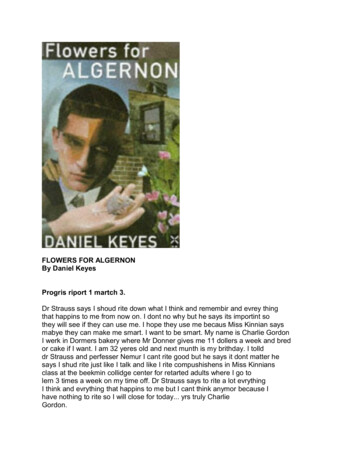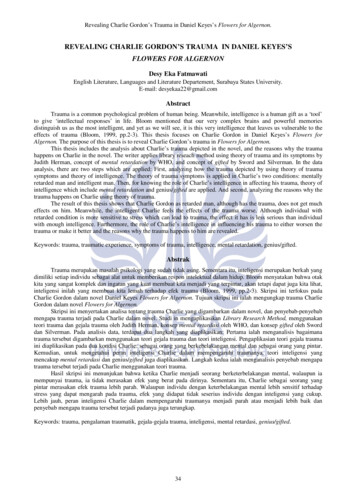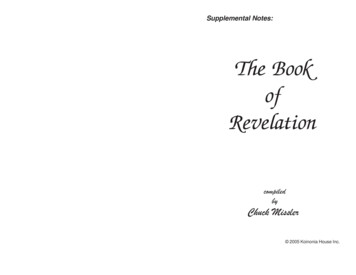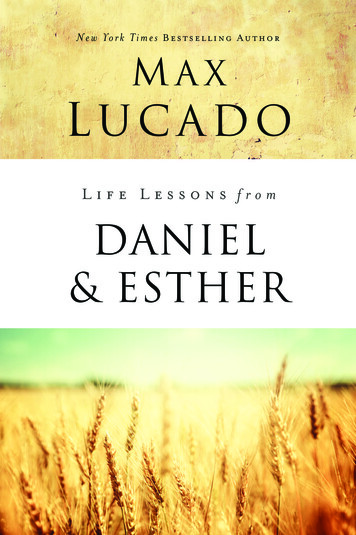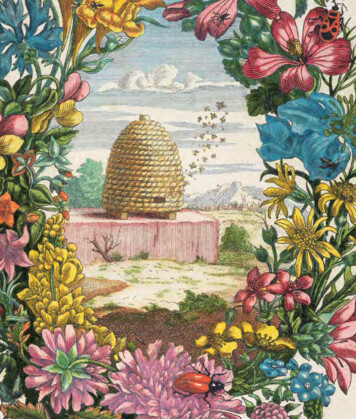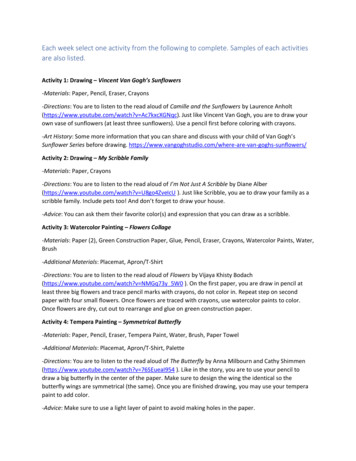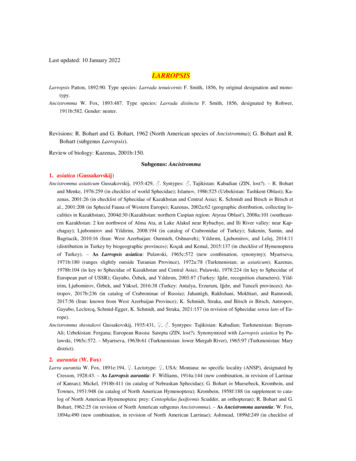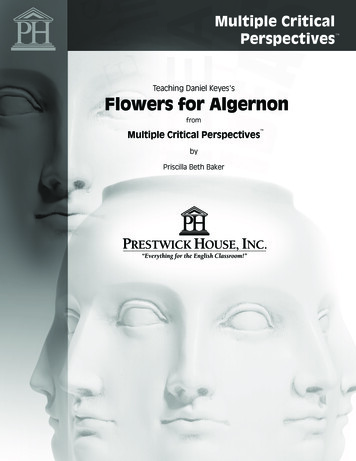
Transcription
Multiple CriticalPerspectivesTeaching Daniel Keyes'sFlowers for AlgernonfromMultiple Critical PerspectivesbyPriscilla Beth Baker
Multiple CriticalPerspectivesFlowers for AlgernonGeneral Introduction to the WorkIntroduction to Flowers for AlgernonDanielKeyeswas born inBrooklyn, New York in 1927. He received a B.A. in psychology fromBrooklyn College and then taught English in the New York City school system. It was there wherehe first conceived of the short story “Flowers for Algernon,” which, after receiving numerous awards, helater expanded into a full-length novel.The novel reflects several key events in Keyes’s own life. Inspired by the strife caused when hisparents pressured him to get a medical degree, which aspiring-writer Keyes did not want, he realizedthat education itself was creating conflict in his family. He further wondered what might happen if onewere actually able to increase a person’s intelligence. Perhaps the event that most inspired the novel,however, was Keyes’s work with a student in his special needs classroom. The student asked if he mightbe able to be in a regular class if he worked hard to “get smart,” a recurring sentiment of Charlie Gordon’sthroughout the novel.In 1958, Keyes submitted the short story version of Flowers for Algernon to Galaxy Science FictionMagazine, but the editors insisted that he alter the ending so that Charlie would remain intelligent andmarry Alice. Keyes refused and eventually sold the unaltered story to The Magazine of Fantasy and ScienceFiction. The novel form, too, was rejected by many publishing companies, as they all wanted a happier,more optimistic ending. Keyes, again, refused the changes. In 1966, he finally made a deal with Harcourt,which agreed to publish the novel in its original form.Flowers for Algernon handles many ethical issues, including the history of electroshock therapy, mentalinstitutions, and society’s treatment of the mentally handicapped. Using Charlie as a first-person narrator, Keyesleads the reader to contemplate the motifs of Science vs. Religion, the Role of Knowledge and Intelligence,Friendship and Loyalty, Personal Dignity, and perhaps most important, the idea of Man Playing God.Because Charlie is himself mentally handicapped, his progression from and regression back to thatstate provides the reader with an unusually honest and poignant insight into his or her own views, fears,impatience, cruelty, and ignorance regarding mentally handicapped individuals. In this way, Keyes’s novelis not just a commentary but a valuable moral lesson.6Pr e s t w i c kHo u s e,In c.
Flowers for AlgernonMultiple CriticalPerspectivesFormalist Approach Appliedto Flowers for AlgernonNotes on the Formalist ApproachThe formalist approach to literaturewas developed at thebeginning of the 20th century and remained popular until the1970s, when other literary theories began to gain popularity. Today,formalism is generally regarded as a rigid and inaccessible means ofreading literature, used in Ivy League classrooms and as the subjectof scorn in rebellious coming-of-age films. It is an approach that isconcerned primarily with form, as its name suggests, and thus placesthe greatest emphasis on how something is said, rather than what issaid. Formalists believe that a work is a separate entity—not at alldependent upon the author’s life or the culture in which the workis created. No paraphrase is used in a formalist examination, and noreader reaction is discussed.Originally, formalism was a new and unique idea. Theformalists were called “New Critics,” and their approach to literaturebecame the standard academic approach. Like classical artists such asda Vinci and Michaelangelo, the formalists concentrated more on theform of the art rather than the content. They studied the recurrences,the repetitions, the relationships, and the motifs in a work in orderto understand what the work was about. The formalists viewed thetiny details of a work as nothing more than parts of the whole. Inthe formalist approach, even a lack of form indicates something.Absurdity is in itself a form—one used to convey a specific meaning(even if the meaning is a lack of meaning).The formalists also looked at smaller parts of a work tounderstand the meaning. Details like diction, punctuation, andsyntax all give clues.Pr e s t w i c kHo u s e,In c.15
Flowers for AlgernonMultiple CriticalPerspectivesActivity OneExamining Allusions, Symbols, and Motifs as Sources of Unity in the Novel1.Copy and distribute the following: Flowers for Algernon: Formalist Activity One, Graphic Organizer One Flowers for Algernon: Formalist Activity One, Graphic Organizer Two Flowers for Algernon: Formalist Activity One, Graphic Organizer Three2.Have students individually complete Graphic Organizer One.NOTE: Ideally, students should complete Graphic Organizer One for homework the night before beginning thein-class activity.3. Have students report their Graphic Organizer One findings and record additional examples of eachdevice/concept on Graphic Organizer Two.4.Write the following questions on the board: Of the allusions, symbols, and motifs Keyes uses, which are the most prevalent? Which particularincidences of these devices are most notable? What do these allusions, symbols, and motifs contribute to the tone of the novel? What do these allusions, symbols, and motifs contribute to the meaning of the novel? How does the author’s use of these allusions, symbols, and motifs help to unify the work as awhole? Do certain devices contribute more to the novel’s unity than others? How?5.Divide the class into pairs or small groups.6. On Graphic Organizer Three, have each group compile a tally of the number of occurrences of theallusions, symbols, and motifs in the text. Additionally, have them consider the questions on theboard and, in the third column of the graphic organizer, make notes on how they might answerthose questions using that particular example.7.Reconvene the class and have groups report their findings.Pr e s t w i c kHo u s e,In c.19
Flowers for AlgernonMultiple CriticalPerspectivesFeminist Theory Appliedto Flowers for AlgernonNotes on the Feminist TheoryFeminism is an evolving philosophy,and its application in literatureis a relatively new area of study. The basis of the movement, bothin literature and society, is that the Western world is fundamentallypatriarchal (i.e., created by men, ruled by men, viewed through the eyesof men, and judged by men).In the 1960s, the feminist movement began to form a newapproach to literary criticism. Of course, women had already been writingand publishing for centuries, but the 1960s saw the rise of a feministliterary theory. Until then, the works of female writers (or works aboutfemales) were examined by the same standards as those by male writers(and about men). Women were thought to be less intelligent than men,at least in part because they generally received less formal education,and many women accepted that judgment. It was not until the feministmovement was well under way that women began examining old texts,reevaluating the portrayal of women in literature, and writing new worksto fit the developing concept of the “modern woman.”The feminist approach is based on finding and exposing suggestionsof misogyny (negative attitudes toward women) in literature. Feministsare interested in exposing the undervaluing of women in literature thathas long been accepted as the norm by both men and women. Theyhave even dissected many words in Western languages that reflect apatriarchal worldview. Arguing that the past millennia in the Westhave been dominated by men—whether the politicians in power or thehistorians recording it all—feminist critics believe that Western literaturereflects a masculine bias, and, consequently, represents an inaccurate andpotentially harmful image of women. In order to repair this image andachieve balance, they insist that works by and about women be added tothe literary canon and read from a feminist perspective.Pr e s t w i c kHo u s e,In c.33
Flowers for AlgernonMultiple CriticalPerspectivesActivity OneExamining the Influence of Female Characters from a Feminist Perspective1.Divide the class into at least seven gender-mixed pairs or groups.2.Assign each group one of the following passages:Progress Report 10, April 27 Beginning with: “In a dream last night, I heard Mom screaming at Dad ” Ending with: “I wish I could see their faces more clearly.”Progress Report 11, May 1 Beginning with: “Why haven’t I ever noticed ” Ending with: “ I’m going to kiss her good night.”Progress Report 11, May 9 Beginning with: “She saw me and waved to me ” Ending with: “I’m in love.”Progress Report 12, June 5 Beginning with: “He has been waiting for his sister ” Ending with: “I never meant to do anything that would hurt her at all.”Progress Report 13, June 10 Beginning with: “‘Are you two ready yet?’” Ending with: “He storms out, slamming the door behind him.”Progress Report 14, June 19 Beginning with: “Met Fay Lillian, my neighbor across the hall.”Ending with: “ just a fire escape away.”Progress Report 16, September 27 Beginning with: “As I approached the house, I had a second shock.” Ending with: “ his cheek pressed against the window pane.”NOTE: Progress Report 14 may not be appropriate for some students; teachers may choose to omit this passageand divide the class into six groups instead of seven.Pr e s t w i c kHo u s e,In c.37
Flowers for AlgernonMultiple CriticalPerspectivesPsychoanalytic Theory Appliedto Flowers for AlgernonNotes on Psychoanalytic TheoryThe term “psychological”(also “psychoanalytical” or “FreudianTheory”) seems to encompass two almost contradictory criticaltheories. The first focuses on the text itself, with no regard to outsideinfluences; the second focuses on the author of the text.According to the first view, reading and interpretation arelimited to the work itself. One will understand the work by examiningconflicts, characters, dream sequences, and symbols. In this way,the psychoanalytic theory of literature is similar to the Formalistapproach. One will further understand that a character’s outwardbehavior might conflict with inner desires, or might reflect as-yetundiscovered inner desires.Main areas of study/points of criticism of the first view: There are strong Oedipal connotations in this theory: theson’s desire for his mother, the father’s envy of the son andrivalry for the mother’s attention, the daughter’s desire forher father, the mother’s envy of the daughter and rivalryfor the father’s attention. Of course, these all operate on asubconscious level to avoid breaking a serious social more. There is an emphasis on the meaning of dreams. This is becausepsychoanalytic theory asserts that it is in dreams that a person’ssubconscious desires are revealed. What a person cannotexpress or do because of social rules will be expressed andaccomplished in dreams, where there are no social rules. Mostof the time, people are not even aware what it is they secretlydesire until their subconscious goes unchecked in sleep.Pr e s t w i c kHo u s e,In c.47
Multiple CriticalPerspectivesFlowers for AlgernonActivity OneAnalyzing the Id, Superego, and Ego as Related to Charlie Gordon1.Review with the class Freud’s Theory of Personality: the Id, Ego, and Superego.2.Copy and distribute the handout Flowers for Algernon: Psychoanalytic Activity One Graphic Organizer.3. Instruct students to individually complete the table in the graphic organizer with evidence ofCharlie’s id, ego, and superego. They should also include page numbers with their examples.4.Divide the class into pairs or small groups.5.Have students compare their findings and answer the following questions on a separate sheet of paper: Which areas of the text highlight the id of Charlie’s subconscious? What are Charlie’s basic desires in id examples? Give examples showing Charlie’s complete lack of conscience or social skills. Which areas of the text highlight Charlie’s superego? Give examples of Charlie’s sense of guilt and his knowledge of socially imposed behavior. Are the socially imposed behaviors learned primarily through parental instruction, Charlie’seducation, or from society as whole? Which areas of the text highlight Charlie’s ego? Give examples of how Charlie finds balance between the id and the superego. How does Charlie ultimately come to satisfy the id in socially acceptable ways?6.Reconvene the class and have each group report its findings.7.Have the class answer the following questions: How does Charlie’s fluctuating mental capacity affect which portion of his subconscious is themost prevalent at any given point in the text? What textual cues does the author provide to help the reader assess Charlie’s current state ofmind? And how do these cues affect the style and tone of the work overall?52Pr e s t w i c kHo u s e,In c.
Introduction to Flowers for Algernon D aniel keyes w a s born in Brooklyn, New York in 1927. He received a B.A. in psychology from Brooklyn College and then taught English in the New York City school system. It was there where he first conceived of the short story "Flowers for Algernon," which, after receiving numerous awards, he


